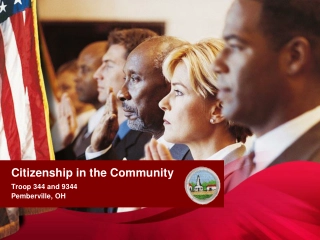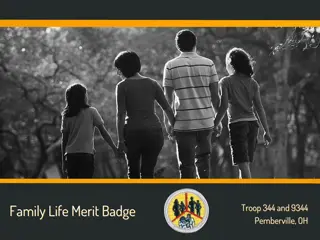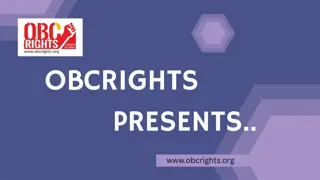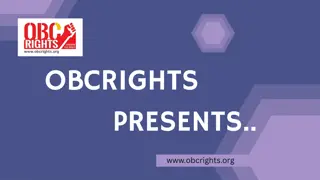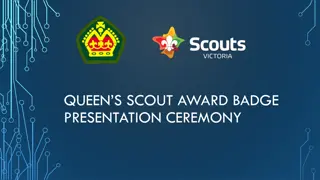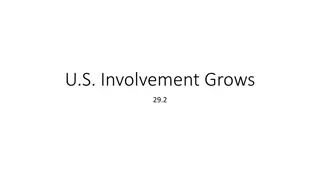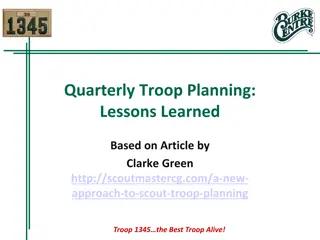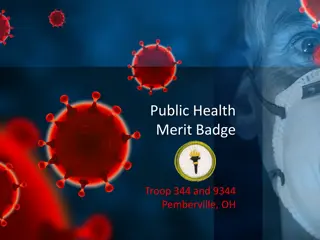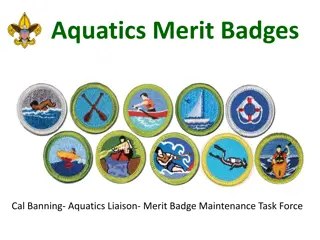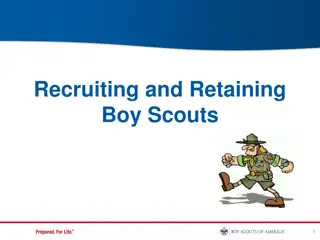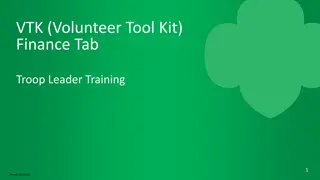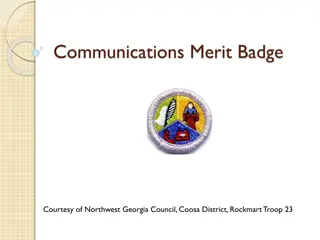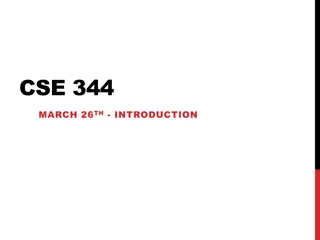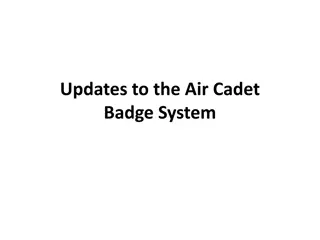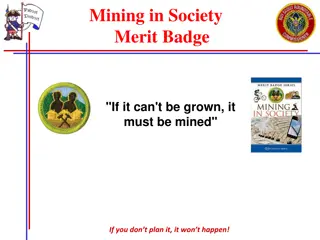Communications Merit Badge Requirements for Troop 344/9344 in Pemberville, OH
Explore the various communication activities and skills required to earn the Communications Merit Badge. Engage in logging, journaling, group discussions, persuasive presentations, interviews, attending public meetings, teaching plans, and opinion sharing to enhance communication abilities. Develop listening skills, creative self-expression, persuasive speaking, and active engagement in diverse viewpoints. Enhance communication strategies through practical experiences and self-reflection.
Download Presentation

Please find below an Image/Link to download the presentation.
The content on the website is provided AS IS for your information and personal use only. It may not be sold, licensed, or shared on other websites without obtaining consent from the author.If you encounter any issues during the download, it is possible that the publisher has removed the file from their server.
You are allowed to download the files provided on this website for personal or commercial use, subject to the condition that they are used lawfully. All files are the property of their respective owners.
The content on the website is provided AS IS for your information and personal use only. It may not be sold, licensed, or shared on other websites without obtaining consent from the author.
E N D
Presentation Transcript
Communications Merit Badge Troop 344/9344 Pemberville, OH
Communications Merit Badge Requirements 1. Do ONE of the following: a. For one day, keep a log in which you describe your communication activities. Keep track of the time and different ways you spend communicating, such as talking person-to-person, listening to teachers, the radio, or podcasts, watching television, using social media, reading books and other print media, and using any electronic communication device. Discuss with your counselor what your log reveals about the importance of communication in your life. Think of ways to improve your communications skills. b. For three days, keep a journal of your listening experiences. Identify one example of each of the following, and discuss with your counselor when you have listened to: 1. Obtain information 2. Be persuaded 3. Appreciate or enjoy something 4. Understand someone's feelings c. In a small-group setting, meet with other scouts or with friends. Have them share personal stories about significant events in their lives that affected them in some way. Take note of how each scout participates in the group discussion and how effectively each scout communicates their story. Report what you have learned to your counselor about the differences you observed in effective communication. d. List as many ways as you can think of to communicate with others (face-to-face, by telephone, letter, e- mail, text messages, social media, and so on). For each type of communication discuss with your counselor an instance when that method might not be appropriate or effective.
Communications Merit Badge Requirements 2. Do ONE of the following: a. Think of a creative way to describe yourself, using, for example, a collage, short story or autobiography, drawing or series of photographs, or a song or skit. Using the aid you created, make a presentation to your counselor about yourself. b. Choose a concept, product, or service in which you have great confidence. Build a sales plan based on its good points. Try to persuade the counselor to agree with, use, or buy your concept, product or service. After your sales talk, discuss with your counselor how persuasive you were. 3. Write a five-minute speech. Give it at a meeting of a group. 4. Interview someone you know fairly well, like, or respect because of his or her position, talent, career or life experiences. Listen actively to learn as much as you can about the person. Then prepare and deliver to your counselor an introduction of the person as though this person were to be a guest speaker, and include reasons why the audience would want to hear this person speak. Show how you would call to invite this person to speak.
Communications Merit Badge Requirements 5. Attend a public meeting (city council, school board, debate) approved by your counselor where several points of view are given on a single issue. Practice active listening skills and take careful notes of each point of view. Prepare an objective report that includes all points of view that were expressed, and share this with your counselor. 6. With your counselor's approval, develop a plan to teach a skill or inform someone about something. Prepare teaching aids for your plan. Carry out your plan. With your counselor, determine whether the person has learned what you intended. 7. Do ONE of the following: a. Write to the editor of a magazine or your local newspaper to express your opinion or share information on any subject you choose. Send your message by fax, email or regular mail. b. Create a web page or blog of special interest to you (for instance, your troop or crew, a hobby, or a sport). Include at least three articles or entries and one photograph or illustration, and one link to some other web page or blog that would be helpful to someone who visits the web page or blog you have created. It is not necessary to post your web page or blog to the internet, but if you decide to do so, you must first share it with your parents and counselor and get their permission. c. Use desktop publishing to produce a newsletter, brochure, flier or other printed material for your scout troop, class at school, or other group. Include at least one article and one photograph or illustration.
Communications Merit Badge Requirements 8. Plan a troop or crew court of honor, campfire program, or interfaith worship service. Have the patrol leaders' council approve it, then write the script and prepare the program. Serve as master of ceremonies. 9. Find out about three career opportunities in communication. Pick one and find out the education, training, and experience required for this profession. Discuss this with your counselor, and explain why this profession might interest you.
Requirement 1 Do ONE of the following: a. For one day, keep a log in which you describe your communication activities. Keep track of the time and different ways you spend communicating, such as talking person- to-person, listening to teachers, the radio, or podcasts, watching television, using social media, reading books and other print media, and using any electronic communication device. Discuss with your counselor what your log reveals about the importance of communication in your life. Think of ways to improve your communications skills. b. For three days, keep a journal of your listening experiences. Identify one example of each of the following, and discuss with your counselor when you have listened to: 1. Obtain information 2. Be persuaded 3. Appreciate or enjoy something 4. Understand someone's feelings c. In a small-group setting, meet with other scouts or with friends. Have them share personal stories about significant events in their lives that affected them in some way. Take note of how each scout participates in the group discussion and how effectively each scout communicates their story. Report what you have learned to your counselor about the differences you observed in effective communication. d. List as many ways as you can think of to communicate with others (face-to-face, by telephone, letter, e-mail, text messages, social media, and so on). For each type of communication discuss with your counselor an instance when that method might not be appropriate or effective.
What is Communication? Communication is the act of sharing information with others. Every communication involves (at least) one sender, a message and a recipient. The sender encodes the message, usually in a mixture of words and non-verbal communication. It is transmitted in some way (for example, in speech or writing), and the recipient decodes it.
Effective Communication Effective communication is the process of exchanging ideas, thoughts, opinions, knowledge, and data so that the message is received and understood with clarity and purpose. When we communicate effectively, both the sender and receiver feel satisfied.
Effective Communication Effective communication sounds like it should be instinctive, but all too often, when we try to communicate with others something goes astray. We say one thing, the other person hears something else, and misunderstandings, frustration, and conflicts ensue. This can cause problems in your home, school, and work relationships.
Effective Communication For many of us, communicating more clearly and effectively requires learning some important skills. Learning these skills can deepen your connections to others, build greater trust and respect, and improve teamwork, problem solving, and your overall social and emotional health.
How to improve your communication skills Here are a few ways to start improving your communication skills: Effective Communication Skill #1: Consider your audience. Knowing your audience can be key to delivering the right messages effectively. 1. Their age, race, ethnicity, and gender can all impact how they ll receive your message. 2. It helps you tailor your message to your audience and engage them, avoid miscommunication, and build relationships.
How to improve your communication skills Effective Communication Skill #2: Practice active listening. Active listening is the practice of giving your full attention in a communication exchange. When communicating with others, we often focus on what we should say. However, effective communication is less about talking and more about listening. Listening well means not just understanding the words or the information being communicated, but also understanding the emotions the speaker is trying to convey.
Tips for becoming an active listener 1. Focus fully on the speaker. You can't listen in an engaged way if you're constantly checking your phone or thinking about something else. You need to stay focused on the moment-to-moment experience in order to pick up the subtle nuances and important nonverbal cues in a conversation. If you find it hard to concentrate on some speakers, try repeating their words over in your head it'll reinforce their message and help you stay focused. 2. Favor your right ear. As strange as it sounds, the left side of the brain contains the primary processing centers for both speech comprehension and emotions. Since the left side of the brain is connected to the right side of the body, favoring your right ear can help you better detect the emotional nuances of what someone is saying. 3. Avoid interrupting or trying to redirect the conversation to your concerns. By saying something like, If you think that's bad, let me tell you what happened to me. Listening is not the same as waiting for your turn to talk. You can't concentrate on what someone's saying if you're forming what you're going to say next. Often, the speaker can read your facial expressions and know that your mind's elsewhere.
Tips for becoming an active listener 4. Show your interest in what's being said. Nod occasionally, smile at the person, and make sure your posture is open and inviting. Encourage the speaker to continue with small verbal comments like yes or uh huh. 5. Try to set aside judgment. In order to communicate effectively with someone, you don't have to like them or agree with their ideas, values, or opinions. However, you do need to set aside your judgment and withhold blame and criticism in order to fully understand them. The most difficult communication, when successfully executed, can often lead to an unlikely connection with someone. 6. Provide feedback. If there seems to be a disconnect, reflect what has been said by paraphrasing. What I'm hearing is, or Sounds like you are saying, are great ways to reflect back. Don't simply repeat what the speaker has said verbatim, though you'll sound insincere or unintelligent. Instead, express what the speaker's words mean to you. Ask questions to clarify certain points: What do you mean when you say or Is this what you mean?
How to improve your communication skills Effective Communication Skill #3: Pay attention to nonverbal signals Nonverbal communication, or body language, includes facial expressions, body movement and gestures, eye contact, posture, the tone of your voice, and even your muscle tension and breathing. In face-to-face conversation, body language plays an important role. Up to 93 percent of communication does not involve what you are actually saying. The way you look, listen, move, and react to another person tells them more about how you're feeling than words alone ever can.
How to improve your communication skills You can enhance effective communication by using open body language arms uncrossed your posture is upright and receptive your palms are open you lean in when speaking or listening or sit on the edge of your seat nod encouragingly. maintain eye contact with the person you're talking to. You can also use body language to emphasize or enhance your verbal message patting a friend on the back while complimenting him on his success, for example, or pounding your fists to underline your message.
How to improve your communication skills Use nonverbal signals that match up with your words rather than contradict them. If you say one thing, but your body language says something else, your listener will feel confused or suspect that you're being dishonest. For example, sitting with your arms crossed and shaking your head doesn't match words telling the other person that you agree with what they're saying. Adjust your nonverbal signals according to the context. The tone of your voice, for example, should be different when you're addressing a child, your peers, or when you're addressing adults.
How to improve your communication skills Avoid negative body language. Negative body language can include: biting your lip nervously looking bored crossing your arms putting your hands on your hips tapping your foot impatiently.
How to improve your communication skills Take into account the cultural background of the person you're interacting with. Body language can have different meanings in different countries that can lead to misunderstandings. In some countries, nodding the head up and down means no while it means yes in the United States. The peace sign or victory gesture may be polite in this country, but is considered rude or insulting in other countries.
Sharing Personal Stories Share your personal story. When listening to another scout s personal story, take note of how each scout participates in the group discussion and how effectively each scout communicates their story. Utilize the questions on the next slide to help identify the differences you observed in effective communication.
Assessing Communication Skills In a small-group setting, meet with other scouts. Each will share personal stories about significant events in their lives that affected them in some way. Take note of how each scout participates in the group discussion and how effectively each scout communicates their story. To assess communication skills of all participants during a presentation, pay attention to: Tone of voice: Are participants friendly, upbeat, and pleasant? Posture: Do participants sit upright and with a respectful stance, or are they lounging casually in the chair? Body language: What positive body language did you observe? What negative body language did you observe? What active listening skills did you observe? Do the participants seem interested in the presentations? Were they attentive? Are they asking relevant questions? Confidence: Do the presenters sound genuine and appear to be sure of themselves? Defensiveness: Are presenters responding negatively to questions that others ask?
Requirement 2 Do ONE of the following: a. Think of a creative way to describe yourself, using, for example, a collage, short story or autobiography, drawing or series of photographs, or a song or skit. Using the aid you created, make a presentation to your counselor about yourself. b. Choose a concept, product, or service in which you have great confidence. Build a sales plan based on its good points. Try to persuade the counselor to agree with, use, or buy your concept, product or service. After your sales talk, discuss with your counselor how persuasive you were.
Write a short autobiography Your autobiographies will be shared during the next meeting. Writing a short autobiography, requires condensing your life story into a concise and engaging narrative. Here's a guide to help you craft a compelling mini- autobiography: 1. Introduction: Begin with a brief introduction that includes your name, place of birth, and the date of birth, providing the reader with essential information. 2. Early Life: Summarize your early years, including significant details about your family, childhood, and formative experiences that influenced your values or interests. 3. Key Milestones: Highlight major life milestones such as education, career, and personal achievements. Mention notable events that have shaped your journey. 4. Passions and Hobbies: Share your interests, hobbies, and passions that define your personality and bring depth to your story. 5. Challenges and Triumphs: Briefly mention significant challenges or obstacles you've faced and how you overcame them. This shows resilience and growth.
Write a short autobiography Guide to help you craft a compelling mini-autobiography (continued): 6. Personal Philosophy: Offer a glimpse of your values, beliefs, or personal philosophies that guide your decisions and actions. 7. Impact and Legacy: Conclude with a reflection on the impact you hope to make or the legacy you wish to leave in the future. 8. Edit and Revise: After drafting, review your mini-autobiography for clarity, conciseness, and coherence. Eliminate unnecessary details. 9. Engaging Language: Use engaging language and vivid descriptions to make your narrative more appealing and relatable. When possible, add pictures or diagrams. 10. Maintain Authenticity: Ensure your mini-autobiography remains authentic and true to your life story. 11. Audience Consideration: Tailor your mini-autobiography to the audience you intend to share it with, adapting the content as needed.
Requirement 3 Write a five-minute speech. Give it at a group meeting.
Writing a Speech Preparing a 5-minute speech can seem daunting, but with a little bit of planning and practice, you can deliver a great speech. Here are some tips to get you started: Choose a topic that you are passionate about and that your audience will find interesting. This will make it easier for you to engage with your audience and keep their attention. Create an outline that includes an introduction, body, and conclusion. The introduction should grab the audience's attention, the body should provide supporting evidence for your main points, and the conclusion should summarize your main points and leave the audience with something to think about. Remember to speak clearly and confidently, make eye contact with your audience, and use gestures and body language to enhance your message. Good luck with your speech!
Writing a Speech For the opening of your speech, start with a hook that will grab your audience's attention, such as a surprising fact, short story, or a thought-provoking question. For the closing, end with a strong statement or call to action that will leave a lasting impression on your audience. When you have finished a simple outline, write the main points and some additional minor points on numbered index cards. Do not write out your speech or try to memorize it word for word. That will result in a stiff-sounding presentation. You want your speech to flow naturally, as it would in conversation. Practice your speech several times before delivering it. This will help you become more comfortable with the material and ensure that you stay within your time limit. 5-Minute Speech Outline Template Use the provided template and sample outline to help you create your speech.
Requirement 4 Interview someone you know fairly well, like, or respect because of his or her position, talent, career or life experiences. Listen actively to learn as much as you can about the person. Then prepare and deliver to your counselor an introduction of the person as though this person were to be a guest speaker, and include reasons why the audience would want to hear this person speak. Show how you would call to invite this person to speak.
Interviewing a Guest Speaker Requesting an interview: Ask your parents permission to contact the person you would like to interview. Call or email the person you would like to interview. Introduce yourself and inform them that you are a Scout. Ask politely if you could interview them as part of your Communication merit badge requirements. Explain that the requirements include interviewing and preparing to introduce a guest speaker but that they are not being asked to be a guest speaker. Ask if they are available to help you, and if so, when would be a good time to talk on the phone or meet so that you could ask some questions. Inform them that you expect the interview to take no more than 10 or 15 minutes. Provide contact information if necessary (phone number or email address) If calling, have your questions along with a notebook and pen available in case they are available to help you at that time.
Interviewing a Guest Speaker When interviewing a person, do not be afraid to politely ask the person to slow down or repeat a statement if you were not able to write down the information fast enough. Questions to help prepare an introduction: What is your full name and professional title? How long have you been in your current position? What are your duties? What position did you have before this one? What do you like best about your career? What is the most difficult challenge you face in your position? Did you go to college or receive special training? What activities or interests do you enjoy when you are not working? Is there anything else you would like to tell me about yourself?
Writing an Introduction for a Guest Speaker Based on the person s answers, write a short introduction of the speaker. Stick to the most important and interesting facts. You do not have to tell everything you learned. Write a few key points on index cards that you can use as reminders. Keep your introduction short. Practice your introduction several times.
Writing an Introduction for a Guest Speaker When giving your introduction, stand up, go to the front of the room, face the audience, and using your notecards give a brief introduction of the speaker. An introduction example: Thank you for coming today to listen to our speaker. Our special guest speaker is Detective Kate Moore, a 10-year veteran with the Wood County Sheriff s Office. Detective Moore has solved many puzzling crimes in our area. She has a bachelor s degree in law enforcement from Bowling Green State University. When she is not working, she teaches karate and coaches softball. Detective Moore has graciously agreed to speak to us today about her position and other career opportunities in law enforcement. Please give a warm welcome to Detective Kate Moore.
Requirement 5 Attend a public meeting (city council, school board, debate) approved by your counselor where several points of view are given on a single issue. Practice active listening skills and take careful notes of each point of view. Prepare an objective report that includes all points of view that were expressed, and share this with your counselor.
Public Meeting Recording a Public Meeting Objectively With your counselor s and your parent s approval, attend a public meeting. You can find a list of public meetings in the local newspaper or on a local government website. Take a notebook and a couple of pens or pencils to the meeting. When you arrive, pick up a meeting agenda if one is available. During the meeting, think of yourself as an observer and try not to judge or form an opinion about the topics of discussion or the people who are speaking. Listen attentively and quietly and record what individuals say about the topics. If an agenda item becomes a topic of debate, record what people on all sides of the issue said and what, if any, action was taken. Stick to the facts and record all viewpoints. Be sure to record the actions taken on each agenda item.
Public Meeting Writing Your Report As soon as you can after you get home, while the meeting is still fresh in your mind, write a report of the meeting. Make the report as unbiased and factual as possible. Do not state your own opinion in the report. Focus most of your report on the topics that were debated or discussed. Keep your report to one or two pages and summarize the main issues and points of view covered at the meeting. Attach a copy of the agenda to your report if one was available.
Requirement 6 With your counselor's approval, develop a plan to teach a skill or inform someone about something. Prepare teaching aids for your plan. Carry out your plan. With your counselor, determine whether the person has learned what you intended.
Teaching a Skill The EDGE method is a four step method for teaching a skill: Explain First explain what you will be doing. Tell them the steps involved. Visual aids might be helpful for this step. Use questions to gauge their understanding. Demonstrate Show them how to do the skill. Demonstrate the steps using the actual materials. Describe what you are doing. Guide Let them practice the skill. Guide and coach them as they try to do it themselves. This step will take the most time. Enable Enable them by letting them do the skill themselves without any intervention.
Teaching a Skill Example of Teaching by the EDGE method: How to make a paper airplane. Explain: Verbally provide the instructions on how to make a paper airplane. Demonstrate: Using a piece of paper, show how to make the paper airplane. Guide: Give each participant a piece of paper and describe each step. As each step is described, the participants do it with their piece of paper. Enable: Give each participant another piece of paper and have them make a paper airplane on their own.
Requirement 7 Do ONE of the following: a. Write to the editor of a magazine or your local newspaper to express your opinion or share information on any subject you choose. Send your message by fax, email or regular mail. b. Create a web page or blog of special interest to you (for instance, your troop or crew, a hobby, or a sport). Include at least three articles or entries and one photograph or illustration, and one link to some other web page or blog that would be helpful to someone who visits the web page or blog you have created. It is not necessary to post your web page or blog to the internet, but if you decide to do so, you must first share it with your parents and counselor and get their permission. c. Use desktop publishing to produce a newsletter, brochure, flier or other printed material for your scout troop, class at school, or other group. Include at least one article and one photograph or illustration.
Preparing to Write a Letter to the Editor Decide on the topic and paper. Your letter to the editor can be a response to a number of things. Most likely, it will be a response to a specific article, but your letter could also be a response to an event or issue in your community. It's best to respond to a particular article that was published by the newspaper. Then, your letter will be more likely to be chosen for publication, and always be ready for rejection. If you are responding to a community event or issue, your local newspaper is likely to be the most appropriate venue for your letter to the editor.
Preparing to Write a Letter to the Editor Before you start writing your own letter, you should read through other letters to the editor of the paper you've chosen to get inspiration. Each paper's letters will differ slightly in form, style, tone, and even in length. Read these letters to get a better idea of how to phrase your letters and to see what appeals to the editors of that paper.
Preparing to Write a Letter to the Editor Most papers will have guidelines for the types of letters they will publish. Most papers have rules regarding the letter's length. They also typically ask that you include your name and contact information for verification. Make sure to read these guidelines before you send off your work. If you can't find the guidelines for submitting letters, call the publication to ask.
Preparing to Write a Letter to the Editor Determine what you hope to accomplish by writing the letter. Some reasons might include: You are angry about an issue and you want people to know about it. You want to publicly congratulate or support something or someone in your community. You want to correct information in an article. You want to suggest an idea to others. You want to influence public opinion or persuade others to take action. You want to influence policymakers or elected officials. You want to publicize a certain organization's work in connection with a current news issue.
Preparing to Write a Letter to the Editor Make sure your letter is timely by sending in your letter shortly after the article in question was published. If you're responding to an article in a weekly newspaper, send in your letter in time for it to be published in the next issue. See the newspaper's guidelines for the publication deadline.
Beginning Your Letter to the Editor Make sure to include your full contact information at the top of your letter. This will include not only your address, but also your email address, and daytime phone number. If your letter is chosen, the editors will use this information to get in touch with you. If the newspaper has an online submission system, it will likely have a space for you to include this information.
Beginning Your Letter to the Editor After your contact information, leave a blank line and then add the date. Write it formally, as you would in a business letter, such as: Feb 25, 2016.
Beginning Your Letter to the Editor If you are writing an email or sending in a physical letter, address the letter as you would a business letter. Include the recipient's name, position, company, and address. If you don't know the editor's name, you can either find it in the newspaper, or you can just write Editor.



